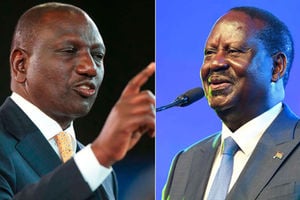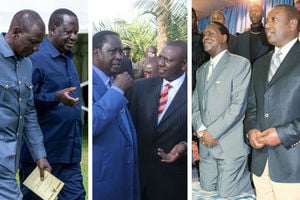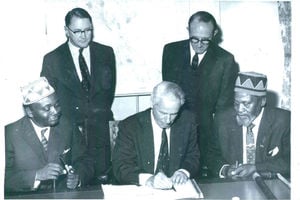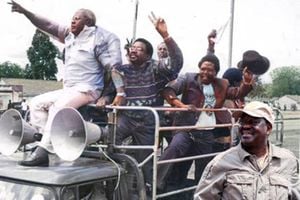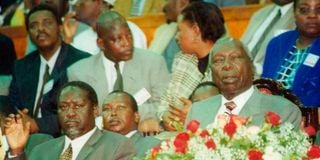
Raila Odinga and President Daniel arap Moi at Kasarani stadium during the Kanu-NDP merger.
When Mr Raila Odinga called reporters to champion the Adani Group bid for Jomo Kenyatta International Airport and the energy sector, he waded into familiar waters where power, sleaze and corporate manoeuvring intertwine seamlessly.
Since his alliance with President William Ruto, framed as a “broad-based” government, and the elevation of his ODM allies into the Cabinet, he has emerged as a defender of the scandal-plagued Kenya Kwanza administration. His ally Opiyo Wandayi, the Energy CS, has already signed a Sh96 billion deal to build and operate powerlines for 30 years. By acknowledging his acquaintance with the Indian businessman behind this venture, Mr Odinga has plunged himself into a precarious situation. Should the deal turn scandalous, he will, politically, end up with the short end of the stick.
Mr Odinga’s ambitions extend beyond relevance. He aspires to be the African Union Commission chairman, a position he seeks with the backing of Dr Ruto. If he is dancing to the President’s rhythm, it is primarily in pursuit of political significance. At 79, the sands of time appear to have slipped through his fingers in the quest for supremacy on the domestic front.
Mr Odinga has been regarded as the opposition leader for years. He now dismantles the label at will, and depending on season, wears the broker tag with ease. He oscillates between an opposition leader and an insider of the ruling regime without battling an eyelid.
To admirers, Mr Odinga is a flexible, shrewd and adaptable politico, no longer bound by the lofty ideals of transparency that defined his earlier years. Critics believe he has evolved into something complex – chameleon-like figure who navigates the political landscape with ease, breathing hot and cold.
When Mr Odinga took advantage of the opportunity presented by the Gen Z uprising to broker a deal with Dr Ruto, he many ruffled feathers. Though he was not involved, he won the spoils by negotiating for a “broad-based government” that saved the regime from infamy. In exchange, he was asked to appoint ODM officials into the government. After his quest for the elusive presidency came to naught, Mr Odinga appears to have come to a realisation: In Kenya, the role of the opposition is not a fixed, adversarial position but rather a fluid institution.
Mr Odinga’s first tango with the establishment came in 1998, when he pole-vaulted from the opposition and forged an alliance with President Daniel Moi. He had been beaten to third position in the 1997 presidential race. His National Development Party (NDP), represented by its iconic tractor symbol, threw its political weight behind Moi’s precarious parliamentary majority. This unusual alliance left many opposition leaders – Kijana Wamalwa of Ford-K, Mwai Kibaki of DP and Charity Ngilu of the Social Democratic Party – in disbelief.
Multibillion-shilling deals
The unlikely partnership saw Mr Odinga evolve into a critical player in Moi’s waning days of power. He was handed the coveted Ministry of Energy in 2001, a portfolio traditionally reserved for the regime’s inner circle, where fortunes and influence flow through multibillion-shilling deals and contracts.
Mr Odinga was also made chairman of the Parliamentary Select Committee on Constitutional Review, putting him at odds with opposition leaders.
During this time, Mr Odinga’s Spectre International Ltd undertook a controversial moves – the acquisition of Kisumu Molasses Plant. The transaction sparked accusations, with critics saying the Odinga family secured the government-owned firm for a fraction of its value. During a parliamentary debate, then-Starehe MP Maina Kamanda accused Mr Odinga of grabbing the plant. The family refuted the claim, saying it paid Sh120 million for the purchase.
The entry of Energem International Ltd, a company with a controversial history in mining in conflict zones, marked a key moment for Spectre. How Mr Odinga forged his connection with Tony Texeira’s Energem is a chapter notably glossed over in his autobiography.
Energem, flush with cash from diamond and mineral ventures across Africa, acquired a 55 per cent stake in the molasses company.
In early public statements, Energem expressed grand ambitions to transform the Kisumu-based plant into a “world-class facility.”
Initially, Mr Odinga had raised money from Kisumu residents to buy the plant, but in this new venture, locals – represented by Kisumu Development Trust – were left with a modest five per cent share, while the Odinga family retained a commanding 40 per cent stake.
Mr Odinga had harboured the hope that Moi would hand him the presidency. But the president had other plans. His gaze was on Uhuru Kenyatta, the son of his predecessor, Jomo Kenyatta.
Mr Odinga severed ties with Kanu, where he had been serving as secretary-general. He brokered another MoU, securing himself a key role in the freshly formed National Rainbow Coalition (Narc), hoping to become the country’s prime minister.
Seeds of discord
As fate would have it, the Narc stalwarts had little faith in his loyalty or ambitions. They reneged on the MoU, sidelining him to ministerial position. Mr Odinga began sowing seeds of discord in the ruling coalition, destabilising president Mwai Kibaki’s first term.
He eventually broke away to form the Orange Democratic Movement (ODM) – positioning himself to challenge Kibaki in the 2007 election. It was after this charged election that Kenya slid into violence. In the negotiations for power, Mr Odinga secured the position of PM and a say in Cabinet appointments.
Later, the Odinga family was accused by the Parliamentary Committee on Agriculture, Lands and Natural Resources of involvement in a maize scandal. Mr Odinga dismissed the findings by the John Mututho-led team as a “nonsense”.
“House committees need to be led by men and women of integrity,” he said.
The Grand Coalition government of Kibaki and Odinga was a house of cards, glued together by the fragile compromise brokered to end the violent aftermath of the 2007 elections. The government was not born out of mutual trust or shared vision, but from pressure exerted by the international community.
Sleaze dominated its the government as each faction competed for a slice of the morsel. There were whispers of a staggering Sh900 million, earmarked for the Kazi kwa Vijana project and channelled through the PM’s office, vanishing.
Mr Odinga found himself summoned to account for this tempest, facing calls to shoulder the political fallout.
He dismissed the outcry, saying MPs were fabricating a storm in a teacup. He admitted an audit query regarding KSh308 million but asserted that the figure was hardly sufficient to cast the entire initiative into the shadows of failure.
During President Uhuru Kenyatta’s second term, after failing to unseat him through the ballot and street protests, Mr Odinga entered into the now-famous handshake deal, which inadvertently sidelined then-Deputy President William Ruto. He harboured hopes that Mr Kenyatta would endorse him for the presidency.
President Kenyatta made a concerted effort to rally Mt Kenya behind Mr Odinga. Dr Ruto outmanoeuvred the two, branding them “dynasties” standing in the way of “the poor”.
As Mr Kenyatta unleashed attacks on those aligned with Dr Ruto, Mr Odinga’s allies enjoyed immunity. Capital Hill earned a reputation as a “cleansing house”, where no evil was heard nor seen.
During the campaign, Mr Odinga and Dr Ruto’s supporters fuelled the fire with such intense vitriol that reconciliation seemed impossible. Dr Ruto and his running mate swore never to allow Mr Odinga a seat at the power-negotiation table.
Mr Odinga is again a force unleashed, backing the agenda of the government. With what remains of his political credibility hanging in the balance, his new-found alliance may also serve a greater purpose: leveraging government support for his bid for the AU Commission position.
@johnkamau1

